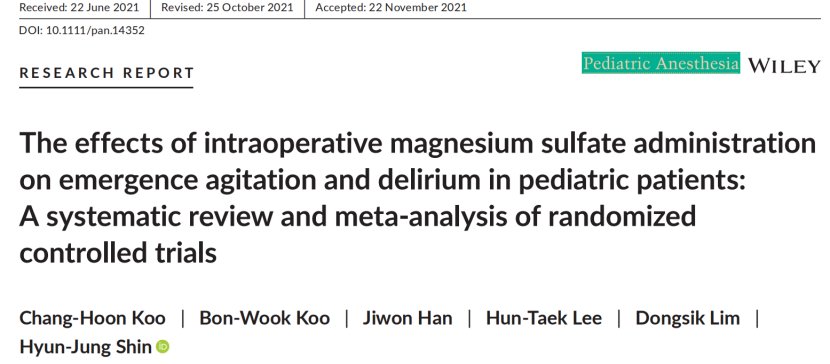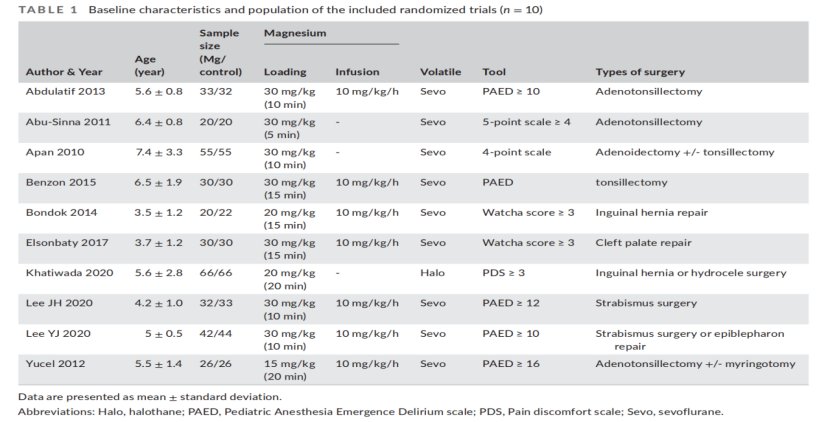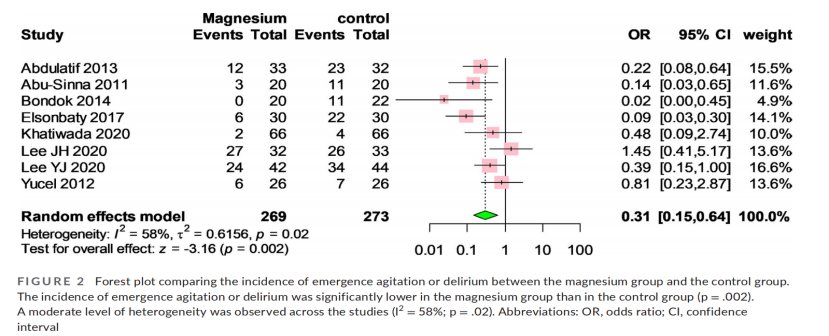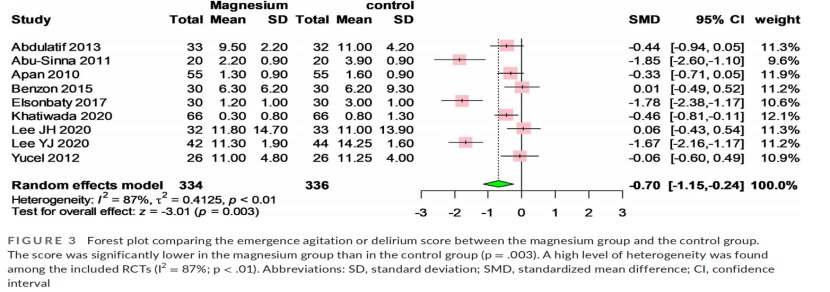关注罂粟花,共同学习麻醉最新文献!
术中应用硫酸镁对儿科患者术后出现躁动和谵妄的影响:一项随机对照试验的系统回顾和meta分析

文章插图
贵州医科大学 麻醉与心脏电生理课题组
翻译:吴学艳 编辑:马艳燕 审校:曹莹
背景及目的
背景:术中使用硫酸镁预防患儿术后出现躁动或谵妄的作用尚不清楚,因为相关随机对照试验报告了相互矛盾的结果。
目的:本研究目的是探讨运用硫酸镁对儿科患者术后出现躁动或谵妄的影响。
方法
检索PubMed、EMBASE、CENTERY、CINAHL、Scopus和Web of Science等电子数据库,查找评估硫酸镁对患儿手术苏醒后躁动或谵妄影响的研究。主要观察指标:在麻醉后住院期间内出现躁动或谵妄的发生率;次要观察指标:是麻醉后病房护理时的躁动或谵妄评分;使用随机效应模型评估比值比和标准化均值差异。
结果
共纳入10项随机对照试验的712例患儿为最终分析。硫酸镁组出现躁动或谵妄的发生率为29.7%,对照组为50.5%。综合效应量显示,使用硫酸镁可显著降低全麻手术患儿术后苏醒期的躁动或谵妄的发生率(优势比,0.31;95%CI,0.15~0.64;p=0.002);此外,硫酸镁组患儿术后躁动或谵妄评分显著低于对照组(标准均数差为,?0.70;95%CI,?1.15 ~-0.24;p =0.003)。
【 【罂粟摘要】术中应用硫酸镁对儿科患者术后出现躁动和谵妄的影响:一项随机对照试验的系统回顾和meta分析】
文章插图

文章插图

文章插图
结论:术中应用硫酸镁可降低小儿患者全麻术苏醒后躁动或谵妄的发生率及严重程度。
原始文献来源: Koo CH, Koo BW, Han J, et al . The effects of intraoperative magnesium sulfate administration on emergence agitation and delirium in pediatric patients: A systematic review and meta-analysis of randomized controlled trials[J].Paediatr Anaesth. 2021 Dec 3. DOI: 10.1111/ pan.14352.
The effects of intraoperative magnesium sulfate administration on emergence agitation and delirium in pediatric patients: A systematic review and meta-analysis of randomized controlled trials
Background: The role of intraoperative magnesium for the prevention of emergence agitation or delirium is unclear as there have been conflicting results reported by several randomized controlled trials.
Aims: The aim of this study was to investigate the effect of magnesium sulfate on emergence agitation or emergence delirium in pediatric patients.
Methods: Electronic databases, including PubMed, EMBASE, CENTRAL, CINAHL, Scopus, and Web of Science, were searched to identify studies which evaluated the effects of magnesium on postoperative emergence agitation or emergence delirium. The primary outcome was the incidence of emergence agitation or emergence delirium during the post-anesthesia stay. The secondary outcome was the agitation or delirium score upon admission to the post-anesthesia care unit. We estimated the odds ratio and standardized mean difference using a random-effect model.
Results: A total of 712 pediatric patients from 10 randomized controlled trials were included in the final analysis. The incidence of emergence agitation or emergence delirium was 29.7% in the magnesium group and 50.5% in the control group. The pooled effect size revealed that the administration of magnesium sulfate significantly reduced the incidence of postoperative emergence agitation or emergence delirium in pediatric patients undergoing surgery with general anesthesia (Odds ratio, 0.31; 95% confidence interval, 0.15 to 0.64; p = .002). Additionally, children in the magnesium group reported significantly lower agitation or delirium scores than those in the control group (standardized mean difference, -0.70; 95% confidence interval, -1.15 to -0.24; p = .003).
Conclusion: The administration of magnesium sulfate reduced the incidence and severity of emergence agitation or emergence delirium in pediatric patients after the use of general anesthesia during surgery.
- 抗疫|【同心抗疫】抗疫一线专家推荐你,春季要常吃这4种对身体好的食物
- 红枣4|【我为群众办实事】公众健康素养大提升|一根葱,三味药!正月葱最嫩、最香,营养最丰富,保健功能也最强
- 科室|【三水人医】专科建设显成效 四级手术来领航
- 葫芦岛市|辽宁葫芦岛:目前转入黄码医院的部分患者和陪护人员大部分达到发病高发期
- 小雨|未来的智能家庭医疗
- 补觉|周末补觉不仅没用,还会让你发胖!
- 肖臻|上海公立医院满意率超95%数字化转型助力便捷就医
- 确诊|湖北昨日新增2例本土确诊病例
- 公司不给员工缴纳“五险一金”,员工也不吭气?这是怎么回事?
- 低谷时人生破局的9个窍门
